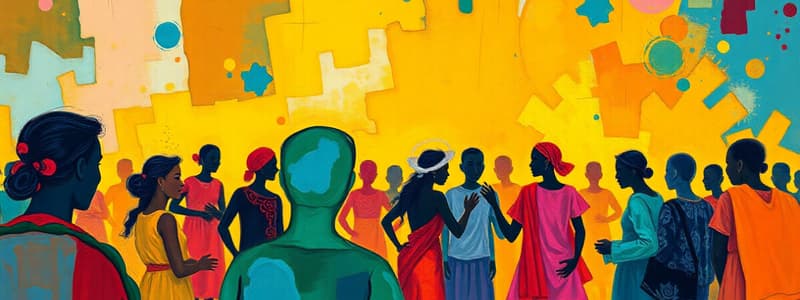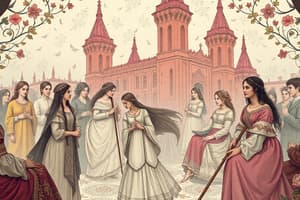Podcast
Questions and Answers
What is the main method of food production in horticultural societies?
What is the main method of food production in horticultural societies?
- Growing crops over a wide area using technical advancements in agriculture.
- Raising livestock on natural pastures.
- Cultivating fruits and vegetables in garden plots. (correct)
- Hunting and gathering wild animals and plants.
Which of the following is NOT a characteristic of pre-industrial societies?
Which of the following is NOT a characteristic of pre-industrial societies?
- They are often subdivided based on their level of technology.
- They rely heavily on traditional methods of food production.
- They are characterized by a strong emphasis on individual competition and profit. (correct)
- Food production is based on human and animal labor.
What is the defining characteristic of feudal society?
What is the defining characteristic of feudal society?
- The reliance on hunting and gathering for subsistence.
- The development of large-scale industrial production.
- The free trade of goods and services.
- The acquisition and ownership of land. (correct)
What is the key economic practice of pre-industrial societies?
What is the key economic practice of pre-industrial societies?
What is the primary economic driver of industrial societies?
What is the primary economic driver of industrial societies?
Which of the following is NOT a type of pre-industrial society?
Which of the following is NOT a type of pre-industrial society?
What is the primary role of conflict in society, according to the provided text?
What is the primary role of conflict in society, according to the provided text?
Which of the following is NOT a characteristic of a society as described in the text?
Which of the following is NOT a characteristic of a society as described in the text?
How does the text explain the importance of 'differences' within a society?
How does the text explain the importance of 'differences' within a society?
How does 'reciprocal awareness' contribute to the formation of society?
How does 'reciprocal awareness' contribute to the formation of society?
What is the primary role of cooperation in the text's explanation of society?
What is the primary role of cooperation in the text's explanation of society?
Which of the following is NOT considered an element of non-material culture?
Which of the following is NOT considered an element of non-material culture?
How does 'likeness' contribute to the formation of society as explained in the text?
How does 'likeness' contribute to the formation of society as explained in the text?
Which of the following best describes the significance of 'interdependence' in the development of society?
Which of the following best describes the significance of 'interdependence' in the development of society?
What is the primary function of norms within a society?
What is the primary function of norms within a society?
How do values influence a person's behavior?
How do values influence a person's behavior?
How does the concept of 'differences' influence the culture of a society according to the text?
How does the concept of 'differences' influence the culture of a society according to the text?
Which of the following is an example of how 'interdependence' contributes to the formation of society as described in the text?
Which of the following is an example of how 'interdependence' contributes to the formation of society as described in the text?
Which of the following best describes the concept of folkways?
Which of the following best describes the concept of folkways?
What is the main distinction between beliefs and ideas?
What is the main distinction between beliefs and ideas?
How do symbols contribute to a culture's identity?
How do symbols contribute to a culture's identity?
Which of the following is an example of a folkway in American culture?
Which of the following is an example of a folkway in American culture?
How do attitudes differ from values?
How do attitudes differ from values?
What is the core distinction between modern societies and post-industrial societies?
What is the core distinction between modern societies and post-industrial societies?
Which of these is NOT a characteristic of culture as described in the text?
Which of these is NOT a characteristic of culture as described in the text?
What does the term 'enculturation' refer to?
What does the term 'enculturation' refer to?
What is the primary characteristic that defines 'material culture' as described in the text?
What is the primary characteristic that defines 'material culture' as described in the text?
How does the text describe the role of adaptation in cultural development?
How does the text describe the role of adaptation in cultural development?
What is the most important distinction between 'enculturation' and 'acculturation'?
What is the most important distinction between 'enculturation' and 'acculturation'?
What does the text suggest is the defining characteristic of a modern society?
What does the text suggest is the defining characteristic of a modern society?
Based on the text, what is the main reason for the shift towards post-industrial economies?
Based on the text, what is the main reason for the shift towards post-industrial economies?
Flashcards
Society
Society
A group of people interacting, sharing a culture and aspirations.
Likeness
Likeness
The similarity among members in a social group creating mutuality.
Reciprocal Awareness
Reciprocal Awareness
The mutual recognition of likeness that distinguishes social members.
Differences
Differences
Signup and view all the flashcards
Interdependence
Interdependence
Signup and view all the flashcards
Cooperation
Cooperation
Signup and view all the flashcards
Mutuality
Mutuality
Signup and view all the flashcards
Social Action
Social Action
Signup and view all the flashcards
Conflict
Conflict
Signup and view all the flashcards
Pre-Industrial Societies
Pre-Industrial Societies
Signup and view all the flashcards
Hunting and Gathering Societies
Hunting and Gathering Societies
Signup and view all the flashcards
Pastoral Societies
Pastoral Societies
Signup and view all the flashcards
Horticultural Societies
Horticultural Societies
Signup and view all the flashcards
Agrarian Societies
Agrarian Societies
Signup and view all the flashcards
Feudal Society
Feudal Society
Signup and view all the flashcards
Industrial Societies
Industrial Societies
Signup and view all the flashcards
Post-Industrial Society
Post-Industrial Society
Signup and view all the flashcards
Mass Production
Mass Production
Signup and view all the flashcards
Culture
Culture
Signup and view all the flashcards
Enculturation
Enculturation
Signup and view all the flashcards
Transmission of Culture
Transmission of Culture
Signup and view all the flashcards
Adaptation
Adaptation
Signup and view all the flashcards
Acculturation
Acculturation
Signup and view all the flashcards
Material Culture
Material Culture
Signup and view all the flashcards
Non-material culture
Non-material culture
Signup and view all the flashcards
Beliefs
Beliefs
Signup and view all the flashcards
Folkways
Folkways
Signup and view all the flashcards
Values
Values
Signup and view all the flashcards
Attitude
Attitude
Signup and view all the flashcards
Laws
Laws
Signup and view all the flashcards
Norms
Norms
Signup and view all the flashcards
Artifacts
Artifacts
Signup and view all the flashcards
Study Notes
Understanding Culture, Society, and Politics - Lecture 2
- Society: A group of people interacting, sharing a common culture, territory, and aspirations.
Characteristics of Society
- Likeness: Similarity among members is fundamental to mutual understanding and social cohesion, often based on lineage, family, or tribal affiliation.
- Reciprocal Awareness: Understanding likeness leads to distinguishing between "us" and "others," forming a sense of commonality and reciprocal relationships.
- Differences: Despite likeness, individuals have inherent differences in nature, desires, and capabilities; these differences are often a source of social strength, not conflict.
- Interdependence: Individuals require the help of others for survival and fulfillment of needs; families and societies rely upon each other.
- Cooperation: Necessary for societal survival and well-being; cooperation prevents conflicts and promotes shared goals.
- Conflict: Necessary for societal formation; conflict and cooperation are inherent aspects of societal growth.
Types of Societies
- Pre-Industrial: Characterized by reliance on human and animal labor for food production.
- Hunting and Gathering: Subsistence on wild plants and animals; nomadic lifestyle.
- Pastoral: Reliance on livestock; more settled than hunter-gatherers.
- Horticultural: Cultivating plants using simple tools; more settled than hunter-gatherers.
- Agrarian: Larger-scale farming; surplus food production.
- Feudal: Land-based social hierarchy.
- Industrial: Driven by machine production and technological innovation.
- Post-Industrial: Information technology, services, and high technology dominate.
- Modern: Mass production and consumer culture; no longer dependent on subsistence.
Culture
- Definition: Culture encompasses knowledge, beliefs, arts, morals, laws, customs, and other attributes of a society. Learned customs and habits for particular groups.
- Characteristics:
- Learned: Culture is acquired through observation, education, and experience.
- Transmitted: Culture passes from one generation to the next through various means.
- Adaptive: Culture adapts to changing environments and challenges faced by a society.
Main Types of Culture
- Material culture: Tangible objects like technology, artifacts.
- Non-material culture: Intangible aspects: values, beliefs, norms, and symbols.
- Elements of Non-material culture:
- Beliefs: Perceptions of reality, influenced by emotions.
- Folkways: Customs and habits, less significant violations.
- Values: Guiding principles about right and wrong.
- Attitudes: Settled way of thinking or feeling.
- Laws: Rules enforced by a society.
- Norms: Standards of behavior.
- Symbols: Things that represent ideas.
- Knowledge: Accumulated facts and beliefs.
- Ideas: Perspectives on the physical, social and cultural world.
Studying That Suits You
Use AI to generate personalized quizzes and flashcards to suit your learning preferences.
Related Documents
Description
This quiz focuses on Lecture 2 of Understanding Culture, Society, and Politics. It examines key characteristics of society, including likeness, interdependence, and the necessity of cooperation for societal cohesion. Engage with the concepts that shape social dynamics and relationships.




